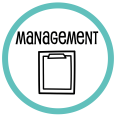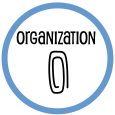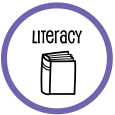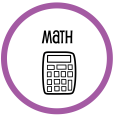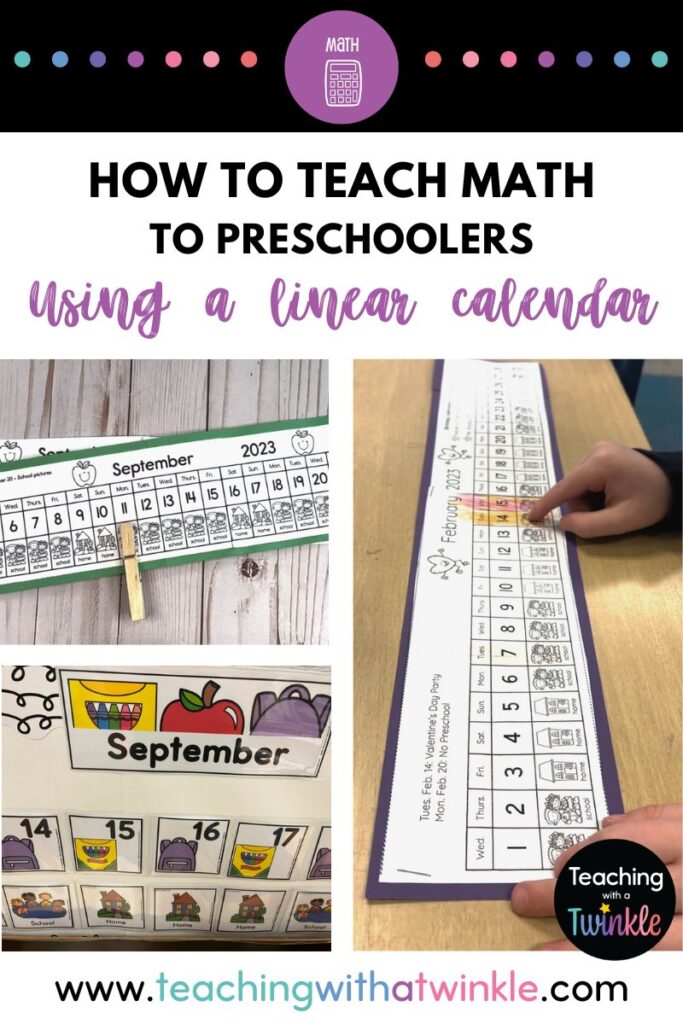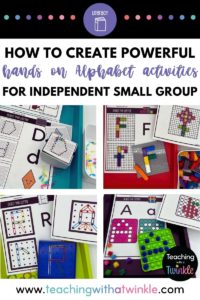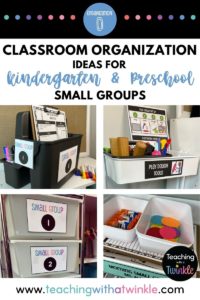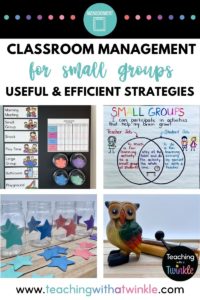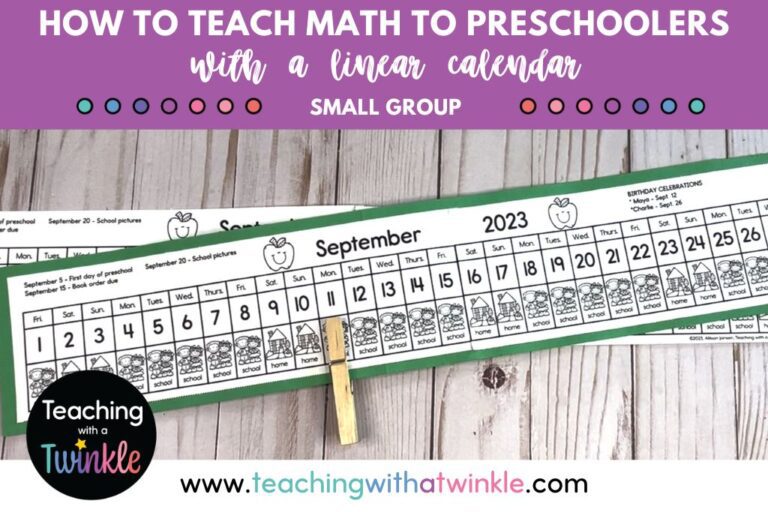
Figuring out how to teach math to preschoolers and kindergarteners can feel like a hefty task. There are SO MANY skills to teach AND students need repeated practice in order to master them. Brush those worries away, teacher friend, because it’s your lucky day! I am going to explain how you can embed FOUR foundational math skills into your daily routine and small group time by using a linear calendar. Teaching counting, number recognition, patterns, and one to one correspondence will feel like a walk in the park!
Be sure to check out the 5 Steps To Setting Up Successful Small Groups in your Preschool or Kindergarten Classroom. This free resource guides you through planning your small group routine!
What is a linear calendar?
A linear calendar displays the dates of a month in one line. The calendar begins with the number one and ends with the last date of the month, typically the number 30 or 31. Of course, there is the month of February, which has 28 days and the occasional 29th day during a leap year.
A linear calendar helps young students experience the concept of time. Displaying the dates in one horizontal line, provides a concrete way of tracking the passage of time. With the dates in one continuous line, there is a clear start and end to each month.
Why use a linear calendar?
I use a linear calendar in my classroom and LOVE it! I am not the only one that enjoys it. My preschoolers are enamored with the linear calendar!
Engaging and Purposeful Linear Calendar
Peek into my classroom on any school day and I guarantee you will hear my students having conversations about how many home days vs. school days, referencing the calendar for upcoming events, and using a pointer to count up to 31!
The linear calendar in my classroom includes pictures that are relevant to the students’ lives. Under each number, there is a picture to represent a school day (kids) or a home day (house). Above each number, I include a picture that represents school events. Some events that I display on the calendar include birthdays, picture day, field trips, dress up days, and substitute days.
Using visuals to mark events on the linear calendar helps young students read and understand what will be going on at school. It peaks students interest and creates a purpose for using the linear calendar. When learning incorporates a clear purpose and student interest, your kiddos will be excited, engaged, and ready to learn!
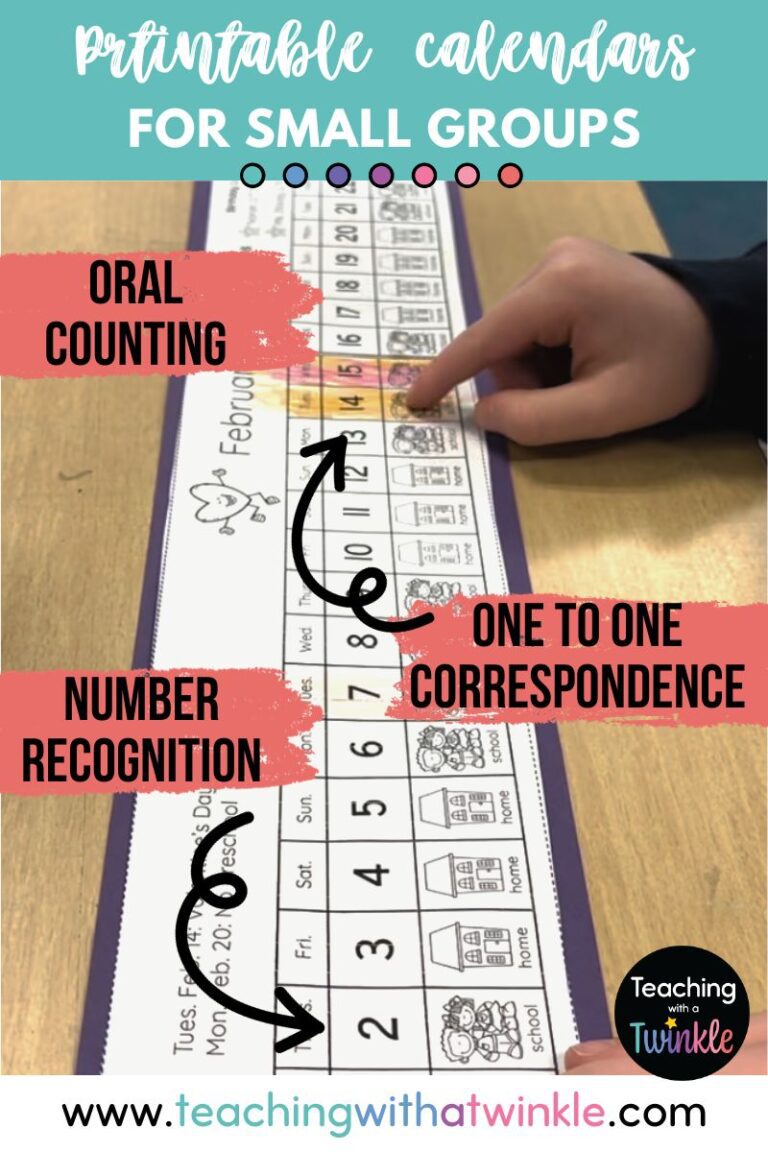
Foundational Math Concepts and Skills
A Linear calendar is a great tool that can help you incorporate repeated exposure and practice of foundational math concepts and skills! You will no longer be questioning how to teach math to preschoolers.
Core math concepts that are easily embedded into linear calendar include:
- Verbal counting
- One to one correspondence
- Number recognition
- Patterns
Verbal counting is simply saying the numbers in order. You are not matching a number to a set or counting objects, instead, you are just saying the numbers in the correct order. Students practice verbal counting as they count using the linear calendar.
One to one correspondence is the ability to point to an object and say a number word at the same time. Little learners who have not yet mastered this skill will count too fast or too slow as they touch or point to an object. Their end result will not match the actual number of objects. A linear calendar is an inviting way to practice this very important skill!
Number recognition is the ability to recognize numbers by their name, by the way they look, and by connecting them to their quantity. Using a linear calendar provides continued exposure to number recognition on a consistent basis. Students will practice finding numbers and identifying numbers as they talk about important dates.
Pattern recognition is understanding that colors, shapes, etc. repeat in a logical way. By using patterned number cards on your linear calendar, young children are exposed to the concepts of identifying patterns and understanding the predictable nature of extending the pattern.
These math skills take time and practice for students to master. Utilizing a linear calendar ensures that your students are routinely practicing these essential early math concepts.
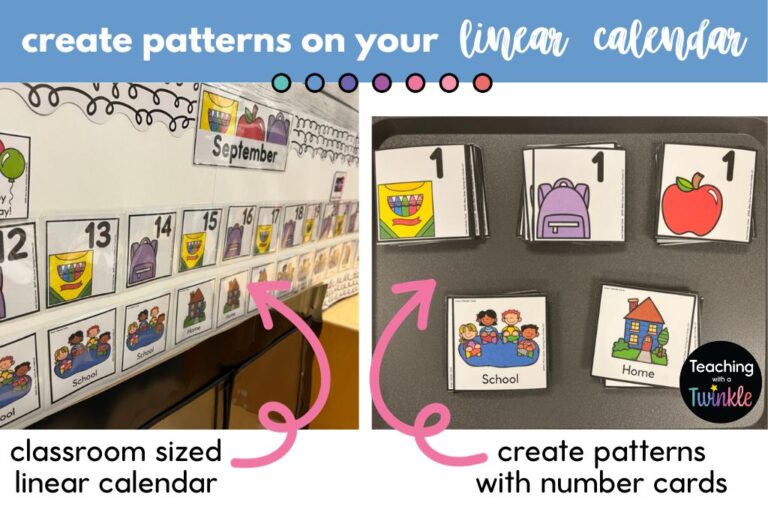
Implementing Linear Calendar
Implementing a linear calendar into your classroom routine is simple. It doesn’t take a lot of time and it provides a big educational impact! There are two structured ways that I consistently implement the linear calendar in my classroom: whole group and small group.
Whole Group Linear Calendar
I implement linear calendar on a daily basis during one of my whole group routines. It only takes about 4-5 minutes to go through our calendar routine. No joke! In 5 minutes (or less), my students have practiced and been exposed to multiple math concepts!
Here is the order of our linear calendar routine.
- I say the day of the week, month, and date and my students repeat after me.
- Start at number one and count up to the current date (number) while I point or a student points with a pointer.
- Recite a number chant and/or talk about what the number looks like (example: if it has more than one digit).
- Write the number in the air.
- Do a movement (stomp, clap, dance, etc.) the number of times that correlates to the date.
- Say the pattern that we see on the number cards, starting at the beginning and stopping at the current date. I also integrate motions for each pattern element that we say.
- Talk about the event picture shown on the calendar for the current date.
I want to mention that as we count on the linear calendar, I keep a rhythm by tapping my leg so the whole class counts at the same pace. Every time I tap my leg, we are saying the next number. This has helped greatly with keeping the entire class counting at the same pace! My other hand is using a pointer to track the numbers on the calendar as we count.
Take a close look at my linear calendar routine and you will notice that my students are practicing verbal counting, one to one correspondence, and number recognition. Since my calendar cards incorporate pattern elements, we also get a little pattern practice in. Now that is a big payoff for a small investment of time! If you are in need of patterned number cards, check out my Linear Calendar Card Set.
Small Group Linear Calendar
Another way I incorporate linear calendar into my classroom is during small groups. At the beginning of each month, I plan a linear calendar small group lesson. This means that every month, my students get their very own “student sized” linear calendar to take home. My preschoolers are antsy with anticipation to get their next monthly linear calendar. Hands down, this is a class favorite!
During small groups, each child has their own linear calendar in front of them. We begin by counting (and pointing) from number one to the last number on the calendar. It is a great way to warm up and practice some counting and one to one correspondence. After that, we talk about important dates (the dates are listed at the top of the calendar). For each date, we start at number one and count until we reach the number associated with the important date. Then we color in that number. We repeat this until we have marked all the special days. Students write their name on the back and put it in their folder to take home.
The linear calendar small group lesson takes approximately 10 minutes to implement. If you have more time to fill, extend the learning with some simple number games using the linear calendar!
- Have a student pick a number card, identify the number and then count together to find it on the calendar.
- Pick a number card and identify the number that comes before or after the card you picked.
- Have students find their favorite number.
- Have students find the number that correlates to their age.
- Cover a number with a small object (like a snap cube) and have the students count to figure out which number is hiding.
- Close your eyes and point to a number. Open your eyes and say what the number is (or count up to that number).
The printable linear calendars that my students take home, include important school dates and student birthdays, as well as, pictures of school days (kids) and home days (house) under each number. The first time a linear calendar goes home, I include a parent letter explaining the linear calendar and ways they can support their child at home using the calendar. I also give each student a clothespin, so they can attach it to the calendar and track the date (home/school day) they are on.
Using a linear calendar as a small group activity has not only benefited my students…it has benefitted me, the teacher! Beyond all the amazing academic and student engagement advantages, here are some more reasons I love implementing linear calendar into my small group routine!
1. STREAMLINES PLANNING
Using a linear calendar as a small group will save you time because it is a recurring activity. This means, you can reuse the activity during every month of the school year. By doing this, you simplify your planning process. At the beginning of each month, you know you will be implementing a linear calendar as one of your small group activities. Go ahead, get out your favorite teacher pen and mark it in your planner!
2. CONSISTENT ROUTINE
Your students will thrive on the consistent routine that a linear calendar small group provides. The lesson provided in the resource will set the routine of your linear calendar small group activity. Utilizing a recurring small group activity helps your students become familiar with the activity and your expectations. They will know what to expect and what to do, which can minimize the number of redirections you need to give!
3. ALIGNED TO LEARNING STANDARDS
Early math concepts are the foundation to more difficult math skills later on. No matter where you teach or the curriculum that you teach, these vital concepts and skills are necessary building blocks for future mathematical thinking.
4. HOME-SCHOOL CONNECTION
Families enjoy being a part of their child’s educational journey! A family letter is included in the linear calendar resource, explaining what a linear calendar is and ways they can support their child at home. I have received a lot of positive feedback from my preschool families. They enjoy the linear calendars that are sent home and have shared that their child regularly interacts with their calendar while at home. Most of my students move their clothespin each day to track if it is a school day or a home day.
How to Make A Linear Calendar
Printable Linear Calendar For Small Group
I have created printable linear calendars with a variety of school week options in order to meet the needs of different program schedules.
Linear calendar template options:
5 Day School Week (school days on Monday-Friday)
4 Day School Week (school days on Monday-Thursday with a home day on Friday)
3 Day School Week (school days on Mon/Wed/Fri, with home days on Tues/Thurs)
2 Day School Week (school days on Tues/Thurs, with home days on Mon/Wed/Fri)
BUNDLE that includes all options above. This is perfect for teachers that teach multiple sections.
All of the linear calendars have an editable header at the top, allowing you to type in important dates specific to your school and classroom. Each calendar template is set with default images for school days and home days below each number. If you need to edit a school day to a home day (or vice versa), you can use the extra icon pages included to cut out a picture and tape it over the picture that needs editing. Then you would make copies of your calendar and assemble it.
Prior to my small group, I prep the printable linear calendars for the month. Here is my process:
- Open up my linear calendar product.
- Find the template for the month.
- Edit the top of the document by adding in special dates. Print.
- Correct any “home” or “school” days.”
- Make copies of the original.
- Cut out and assemble. Add in day 31 if the month has 31 days.
If you have a classroom assistant or some eager parent volunteers, you can have them prep the calendars after you have made copies. Give them a sample finished calendar to reference, and off they go to get assembled!
Classroom Linear Calendar
When I first made the shift from a traditional calendar to a linear calendar, my first question was, “Where do I get a linear calendar?” After some very important research on Google and Pinterest, I had found one product created by an educational company that would fit my needs, but not my price point. That is when I concluded that I would DIY my own linear calendar.
The second question I asked myself was, “Where am I going to put it?” It is no secret that a linear calendar takes up some space. For me, I had a very unique challenge. My classroom is part of an open concept school, so wall space is limited. I rearranged to make room for my linear calendar.
After answering my own questions, it was time for me to make a linear calendar. Here are the supplies that I used:
- Tagboard and/or foam core board (dollar store)
- 62 Clear adhesive labeling pockets (approx. 3 ⅝ inches x 3 ⅝ inches)
- 1 Clear adhesive nameplate sleeve (approx. 3 ¼ inches x 9 ¾ inches)
- Clear packing tape
- Bulletin board border
- Yard stick
Depending on where you choose to display your linear calendar, consider if you would use tag board or foam core board for the background material. If you have a large bulletin board that you can staple your calendar to, tagboard is the way to go. If you are planning to hang your calendar on a regular wall (drywall or brick), I suggest using foam core board as your background to make your calendar sturdy for hanging.
I originally used tagboard as the background of my linear calendar. When I went to hang it on the wall, it was a little floppy, so I went back and added foam core board to the back to make it more sturdy.Check out this DIY Linear Calendar video that I made. I walk you through each step of creating your very own linear calendar.
Here is how I made my DIY linear calendar.
- First, I figured out the overall height and length of my calendar. The first row. There was about ¼” – ½” of space between the two rows. I laid out the rectangular nameplate sleeve at the top. This holds my month header card. I wanted enough room around the clear pockets in order to add a decorative border. At the time, I ballparked it and it ended up being 16 inches high and 9 feet long.
- Then, I cut multiple pieces of tagboard 16 inches high and however long the piece of tagboard was. I used clear packing tape on the back of the tagboard pieces to secure them together into a 9 foot long strip.
- Next, I added the two rows of 31 adhesive pockets. The top row for number cards and the bottom row for picture cards. To center the adhesive pockets, I found the middle of the tagboard from top to bottom and side to side. I started placing the pockets from the middle, moving towards the outside edges. Between the two rows of pockets, I left about ¼” – ½” of space.
- Last, I added bulletin board border along the outside edges to give it a finished look. Since I needed my calendar to be a little more sturdy, I went back and taped pieces of foam core board to the back of the tag board. I hung my linear calendar on the wall using removable wall hooks and book rings.
Ta-Da! My giant linear calendar is complete! In the top row, I used number cards with picture patterns. In the bottom row, I placed “home” and “school” day cards. If it is a school day, the school day picture card goes under that particular number. Same goes for the home day cards. For special days, I put the picture card on a popsicle stick and place the popsicle stick in the top row number pocket. I also place day of the week cards in the current week we are in. These move as we progress through the month. I use a star that says “today” on a popsicle stick to show the current day. This gets moved daily. I also display the month tag in the clear rectangular name plate pocket at the top. Check out my linear calendar cards! This resource includes everything you need for your very own linear calendar!
Display the linear calendar at the students level. By doing this, they will be able to interact and reference the calendar throughout the day. At playtime, my students enjoy using a pointer and counting each number on the linear calendar. There is always a “wait” for a turn to do this!
Satisfy your craving for more learning!
- Everyday Classroom Management for Small Groups: Useful and Efficient Strategies
- How to Create Powerful Hands On Alphabet Activities for Independent Small Group
- How to Make and Implement a Linear Calendar
- How to Make and Use a Linear Calendar in Preschool
- The Power of Linear Calendars in the Preschool Classroom
Through daily practice, my students’ number sense concepts and skills are rock solid by the end of the school year. The linear calendar plays a large role in my students’ engagement and repeated exposure to foundational math concepts! No longer will you question how to teach math to preschoolers. Give it a try and I am sure you will have similar results!

